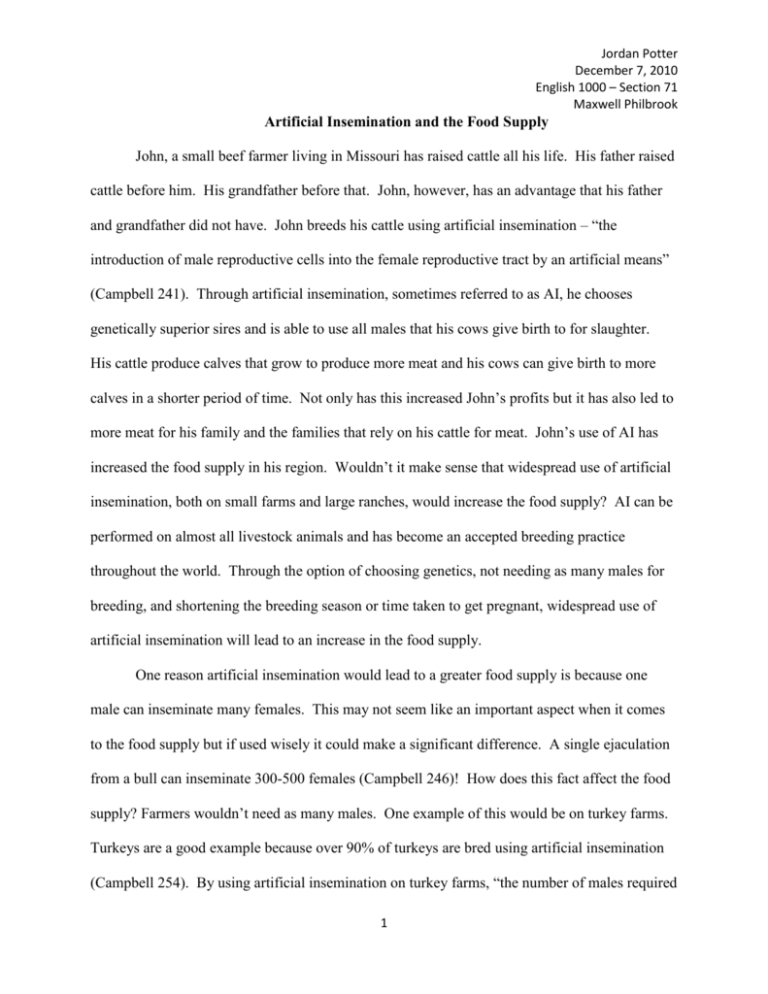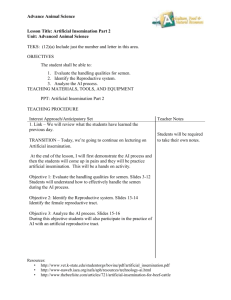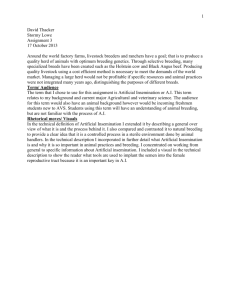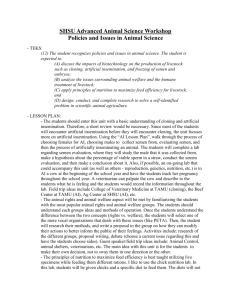Artificial Insemination and the Food Supply
advertisement

Jordan Potter December 7, 2010 English 1000 – Section 71 Maxwell Philbrook Artificial Insemination and the Food Supply John, a small beef farmer living in Missouri has raised cattle all his life. His father raised cattle before him. His grandfather before that. John, however, has an advantage that his father and grandfather did not have. John breeds his cattle using artificial insemination – “the introduction of male reproductive cells into the female reproductive tract by an artificial means” (Campbell 241). Through artificial insemination, sometimes referred to as AI, he chooses genetically superior sires and is able to use all males that his cows give birth to for slaughter. His cattle produce calves that grow to produce more meat and his cows can give birth to more calves in a shorter period of time. Not only has this increased John’s profits but it has also led to more meat for his family and the families that rely on his cattle for meat. John’s use of AI has increased the food supply in his region. Wouldn’t it make sense that widespread use of artificial insemination, both on small farms and large ranches, would increase the food supply? AI can be performed on almost all livestock animals and has become an accepted breeding practice throughout the world. Through the option of choosing genetics, not needing as many males for breeding, and shortening the breeding season or time taken to get pregnant, widespread use of artificial insemination will lead to an increase in the food supply. One reason artificial insemination would lead to a greater food supply is because one male can inseminate many females. This may not seem like an important aspect when it comes to the food supply but if used wisely it could make a significant difference. A single ejaculation from a bull can inseminate 300-500 females (Campbell 246)! How does this fact affect the food supply? Farmers wouldn’t need as many males. One example of this would be on turkey farms. Turkeys are a good example because over 90% of turkeys are bred using artificial insemination (Campbell 254). By using artificial insemination on turkey farms, “the number of males required 1 Potter per flock is reduced five – to tenfold” (Gordon 258). This same idea could be carried over into cattle ranching. If a single bull can produce 500 calves then why have so many bulls on each ranch? Since there’s not a need for so many males, a few could be kept on the farm for breeding purposes and the others could be butchered. Another option would be to not have any males on the farm. Semen could be collected from select desired males and then all the males could be sent to butcher. This meat from the males that aren’t needed would be a great amount of meat added to the food supply. Also, the land and resources used to raise males on farms and ranches could instead be used to raise more females. If there are more females, these animals would eventually become pregnant and lead to more births, which, would lead to more food. Application of this process could apply to any farm animal. Using artificial insemination to impregnate cows, sheep, goats, poultry, and other female farm animals could lead to more resourceful use of males. Another reason why artificial insemination is such a large step for farmers and ranchers is that the breeders have the option to select genetically superior sires to breed their females to. Through natural service, there might be several males in a herd and the female can be bred by whoever gets to her first when she goes into heat. However, with artificial insemination, farmers and ranchers can choose which male’s semen to use. In addition to choosing which male on the farm or ranch, breeders also have the option to use semen shipped in from other males. According to Dr. Dietrich Volkmann, professor in food animal theriogenology, “The best, ideal bull or stallion won’t be roaming the field; they’ll be in a stud somewhere.” A stud is where bulls, rams, and other males are kept for their semen to be collected for artificial insemination. These animals kept in the stud are usually genetically superior to most bulls on farms and ranches throughout the country. Through artificial insemination even smaller farms have access 2 Potter to genetically superior males (Campbell 243). Genetic improvement of herds can also be improved 3 to 4 times faster through artificial insemination than by natural selection (Campbell 243). This is because the genetic selection makes the steps of improvement so much bigger. Why does genetic improvement make an impact on the food supply? Through genetics, breeders can choose sires that produce more meat, or will cause increases in milk production. According to John R. Campbell, author of Animal Sciences: The Biology, Care, and Production of Domestic Animals, dairy cows bred with AI produced an additional approximately 8 billion pounds of milk annually than the same number of cows bred with natural service (243). Likewise, slaughter steers bred by AI produced “over 40 million additional pounds of edible meat annually” than steers bred through natural service (Campbell 243). It’s easy to agree that “the foremost value of artificial insemination in farm animals lies in its use as a tool for the genetic improvement of livestock (especially of traits having economic importance)” (Campbell 241). The third reason that widespread use of artificial insemination would increase the food supply is because the breeding season can be shortened or even shifted. A breeding season is the time that it takes for an animal to go through the estrous cycle and become pregnant. This breeding season can be shortened through a process known as estrous synchronization. According to Animal Sciences: The Biology, Care, and Production of Domestic Animals, estrous synchronization is “manipulating the reproductive processes so females can be bred during a short, predefined interval with normal fertility” (Campbell 233). Usually this process is done with chemicals to make the females go into heat when the breeder wants them to. This is easier for artificial insemination because all animals can be bred on the same day. Estrous synchronization wouldn’t be as effective with natural service because bulls would have to try to impregnate all the females on the same day within a short period of time. Estrous 3 Potter synchronization leads to more births because “the breeding season can be shortened because more females become pregnant during the first week of breeding” (Bearden 223). If it takes less time for the females to get pregnant each time, then added together that would mean the same number of babies can be birthed in a shorter period of time. This would add more meat or milk to the food supply. Also, estrous synchronization can allow breeders to shift when their livestock animals have their young. This would lead to more food because it could result in fewer deaths of babies. For example, many farmers lose calves in the winter due to cold. These farmers could instead choose to breed their cows so that they wouldn’t give birth in the colder parts of the year. Also, estrus synchronization can affect the food supply because farmers can choose to breed during favorable marketing patterns (Bearden 223). This means that farmers and ranchers can make sure to have meat and milk during low points of the year. Estrous synchronization paired with artificial insemination would lead to shorter breeding season and, therefore, more calves. Farmers are stubborn. It’s hard for them to change their ways. That’s the problem with changing to artificial insemination. It’s so radically different. 50 years ago farmers would have thought that the idea of using artificial insemination was insane. However, more recently artificial insemination has become an accepted practice for breeding animals. Also, it has been on the rise. It’s just a matter of time before almost all animals are bred using AI because of the benefits economically. The benefits of artificial insemination extend even beyond the farmer. Widespread use of artificial insemination would increase the food supply. Through artificial insemination males can be used more resourcefully as meat. Females can be bred to sires with superior genetics. More babies can be produced in the same amount of time due to a shorter breeding season. If 4 Potter small and large farmers and ranchers began using artificial insemination the food supply could be greatly increased. John has taken the step, will you? 5 Potter Works Cited Bearden, Joe H. and Fuquay, John W. Applied Animal Reproduction: Fifth Edition. Upper Saddle River: Mississippi State University, 2000. Print. Campbell, John R. et al. Animal Sciences: The Biology, Care, and Production of Domestic Animals. Long Grove: Waveland Press, Inc., 2003. Print. Etches, R. J. Reproduction in Poultry. Ontario: University of Guelph, 1996. Print. Volkmann, Dietrich H. Personal Interview. 17 October 2010. 6






